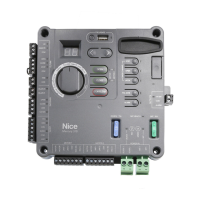Mercury 310 Automated Gate System
Installation and Programming Manual
6464
10.6.1 Vehicle Detectors And Loops
A vehicle detector passes a small current ow through the “loop” of wire, which then becomes an inductive
coil. When a vehicle passes over the loop, the detector senses resultant drop in inductance and actuates
detector output.
LoopCongurations:Congurations dier depending on application. In parking applications, a loop may be
as small as 4 x 6 ft (122 x 183cm). In trac applications employing one of our swing or slide gate operators,
the smallest loop should not be less than 6 x 6 ft (183 x 183cm) in order to detect high bed vehicles.
10.6.2 Security Gate Application Rules
’ Side of the loop closest to the gate must be located at least 4 feet from the gate when gate is closed.
’ Shortest side of loop should be between 6 and 8 feet (1.8m and 2.4m) in length. Longest side of loop
should be between 6 and 20 feet (1.8m and 6.1m) in length. For applications that need to span a wide
area, use several smaller loops. Do not connect more than 200 square feet (18.6sq. m) of loop area to a
single detector.
’ In applications with multiple loops, keep each loop 4 ft (122cm) to 6 ft (188cm) apart. This avoids “cross
talk”. It is possible to have loops closer together by selecting dierent frequencies.
’ For greater sensitivity and less chance of false calls caused by the motion of the gate, it is better to use
multiple smaller loops, connected in a series circuit, to one detector instead of a single large loop.
’ To avoid interference, keep loops at least 2-inches (5cm) above any reinforcing steel. Do not route loop
wires with, or in close proximity to, any other conductors, including other loop leads, unless shielded lead-
in cable is used. Never route high voltage circuits in PVC conduit near a loop.
’ Loop and lead-in wire should be one continuous piece. Avoid splices, if possible. If a splice is necessary
for any reason, “pot” the splice in epoxy or use heat shrink to ensure that the quality of the splice covering
is the same as the original wire jacket.
’ Use 14, 16, or 18 gauge stranded wire with a direct burial jacket. Cross linked polyethylene insulation
types, such as, XLPE or XHHW, will last much longer and are less prone to damage during installation
than conventional insulation types. Preformed loops can be used before road surfacing or under pavers.
’ Twist loose tails of lead-in wires tightly, approximately ten times per foot. See Figure 63.
’ Follow this guide for the correct number of turns in the loop:
¾ 12 to 20 sq. feet (3.7 to 6.1 sq. m) = 5 turns
¾ 20 to 60 sq. feet (6.1 to 18.3 sq. m) = 4 turns
¾ 60 to 240 sq. feet (18.3 to 73.1 sq. m) = 3 turns
10.6 LOOP INSTALLATION
NOTICE
The following are general instructions for installing generic vehicle loops detectors. If installing
loop detectors, the manufacturer’s instructions should have priority over these guidelines.
Mercury 310
www.ApolloGateOpeners.com | (800) 878-7829 | Sales@ApolloGateOpeners.com

